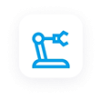Technology has had a profound effect on the way we live and work. One area that we might not instinctively think of when talking about robotics is agriculture. However, now that scenario is changing as well.
The introduction of robots in agriculture made automation viable for agriculture. The sensors utilized in these robots ensure that they can differentiate between different objects. This capability removes a major concern of whether the robot could trample the crops in the process.
Let’s look at the latest robotic technologies that have made their way to agriculture.
Self-Driving Tractors
Self-driving tractors are a reality now. The concept of self-driving tractors is simple: While operating driverless, it completes a task, be it tilling, laying seed, or weeding, as well or better than it could with a human driver.
This breakthrough capability may look like fiction, but with advancements in sensor technology and GPS tracking solutions, self-driving tractors are already in use in agriculture around the world.
The self-driving tractor can adjust its direction, speeding and the attached machinery according to the plowing area. For example, the tractor will stop plowing or harvesting when it reaches the end of a field and continues again after it has moved on to the next row.
Case IH Autonomous Magnum ACV is an excellent example of how autonomous machines can help with farming.
Robot Weeders
Weeds can cause serious harm to crops if left unattended. The conventional weeding process involves the use of chemicals. However, the poisonous nature of the pesticide is not ideal for crops. If we consider the amount of time it takes for a farmer to go around the field looking for weeds, a large-scale pesticide application seems the only better option.
However, employing robots for weeding takes out the time and effort factor, since the robot can move around the field and spray pesticides on the weeds without any manual intervention.
Ecorobotix and Tertill are examples of autonomous robots that go around the field, identify weeds and exterminate them autonomously. These robots operate using solar power and feature cameras to capture images of the ground. The underlying AI model then identifies the weeds and instructs the robots to destroy them.
Robot Fruit/Vegetable Pickers
With advancements in imaging technologies and AI, robots can now identify fruits and vegetables from their plants. Today’s robots can even differentiate ripe fruits/vegetables from unripe ones.
Robot fruit/vegetable pickers survey the farm for produce. Once the robot sees a fruit /vegetable ripe for the picking, it will use its arm to pluck the produce from the plant gently. Pressure sensors at the touchpoints ensure that the robot does not apply unnecessary pressure to damage the produce.
The latest autonomous robot from Tevel Aerobotics Technologies is a fruit-picking drone.
The robot uses its cameras in conjunction with the AI to locate fruit-bearing trees and then carefully pluck the ripe ones.
Root AI is another company pioneering in harvesting robots. Their creation, Virgo 1, is not airborne but can carry out the same plucking operation at ground level.
The robot has successfully showcased its abilities by plucking ripe tomatoes from its plant using a series of cameras to identify the right color and soft grippers to remove the fruit from the plant.
Seeding Robots
Robots are not only effective at harvesting but are equally good at seeding, which is a process of planting seeds in the ground.
Several research papers show the viability of using robots in seeding. Since they can be controlled remotely or move around a pre-planned route, it can save more time for farmers.
These robots come equipped with LiDAR sensors that can easily identify objects within a distance of 40 meters and a view angle of 270°. Once the LiDAR detects a foreign object in its field of view, it can trigger necessary actions such as stopping the vehicle and alerting the farmer. Another advantage of such robots is that they can remain active 24/7 without any fatigue.
The Role of Sensors in Farming Robots
Robots in agriculture are a testament to the advancements we have made in automation. However, The decision-making capabilities of these intelligent machines largely depend on the sensors they are equipped with. From preventing collisions to detecting objects in the field, sensors enable robots to perform the desired repetitive task with the required precision and accuracy. Since farming is an activity that happens mostly outdoors, the sensing devices must also feature a robust design to allow accurate operation in all weather conditions.
At Hokuyo-USA, we provide industry-leading sensors for a range of farming automation applications. Contact us to learn more about the sensor products we offer and their integration.

 Factory Automation
Factory Automation Logistics Automation
Logistics Automation Process Automation
Process Automation Crane Collision Avoidance
Crane Collision Avoidance LiDAR/Obstacle Detection
LiDAR/Obstacle Detection Safety Laser Scanners
Safety Laser Scanners Optical Data Transmission
Optical Data Transmission Hot Metal Detectors
Hot Metal Detectors Laser Distance Sensor
Laser Distance Sensor Blog
Blog Whitepapers
Whitepapers Case Studies
Case Studies Infographics
Infographics